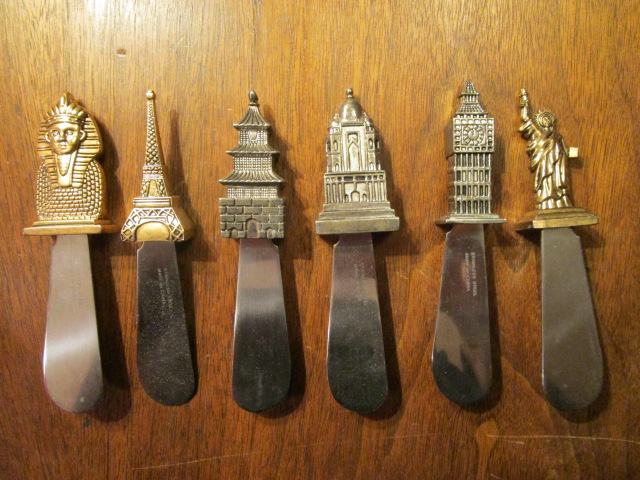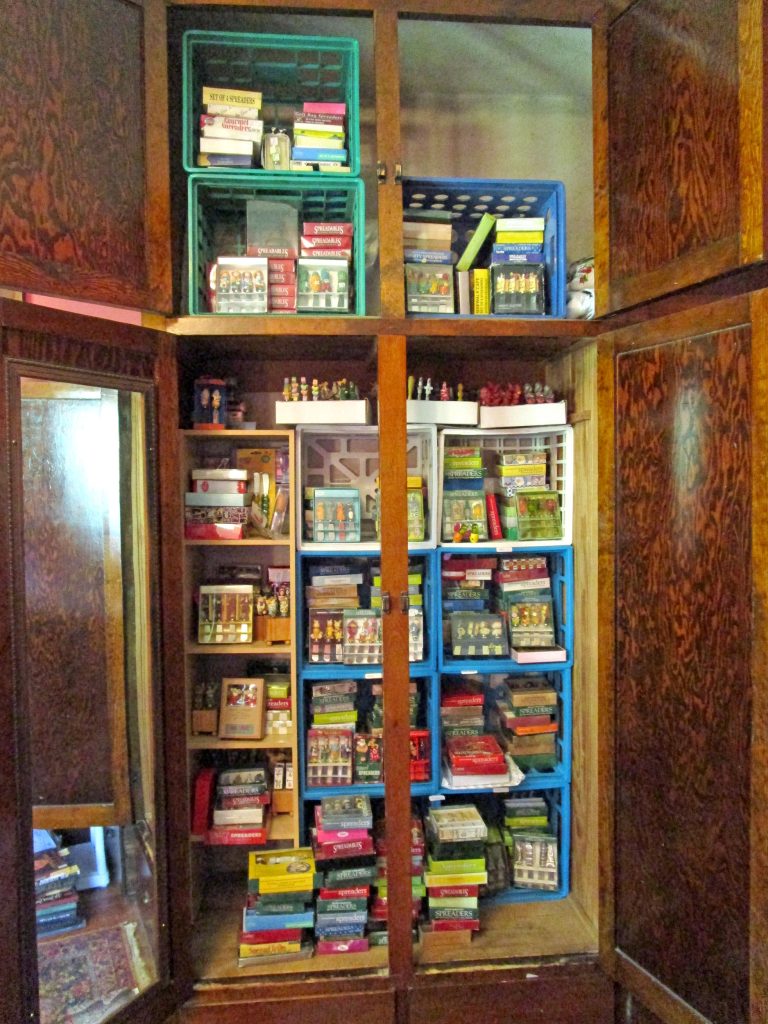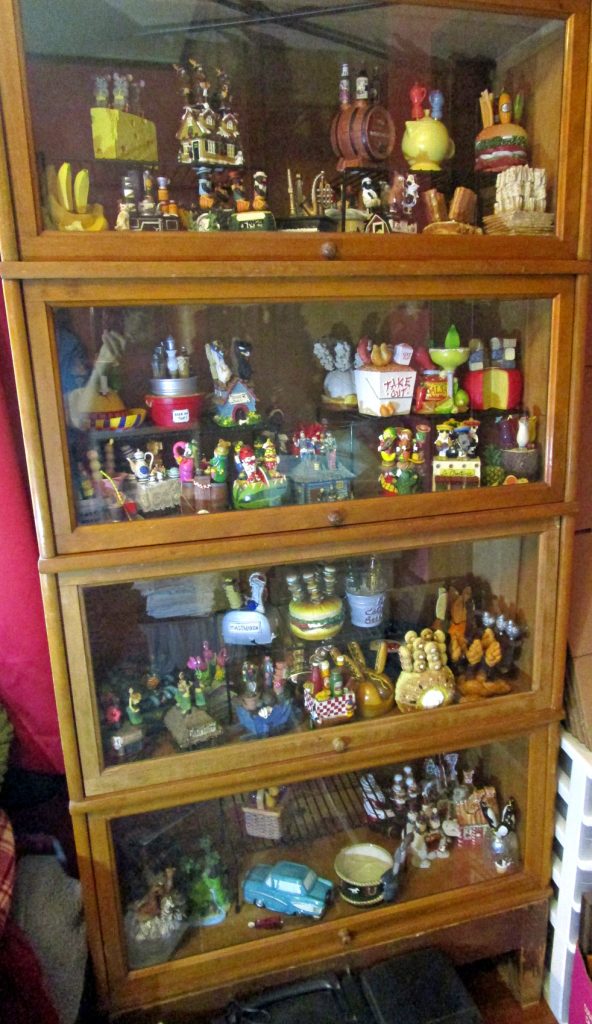Collecting Spreaders

Like any collector, I am torn between two conflicting urges: 1) the urge to find and cultivate new collectors to facilitate collegial correspondence and mutual admiration of our collections (and also to convince myself that it’s not, in fact, totally weird to collect something like cheese spreaders); and 2) the urge to keep the collecting of cheese spreaders a secret and get all the good ones for my own collection.
I’ve decided to take the high road and try to encourage a more serious appreciation of collecting spreaders.
Here are a few tips on collecting them (note: because I am not aware of any other serious collectors, I have had to make up some of these as I go along):
1. Finding Cheese Spreaders
The best place to find spreaders is online, on sites such as Ebay, Etsy, Poshmark and Mercari, although shipping costs make them more expensive than finding them in thrift stores such as Goodwill and consignment stores. However, such local finds are increasingly few and far-between and depend on regularly frequenting such stores (having friends or relatives who are regular Goodwillers promise to purchase for you any cheese spreaders they run across is a good tactic).
Figural resin-handled cheese spreaders have been declining in popularity among the general public since about 2005. Their original manufacturer, Boston Warehouse, rarely makes any new ones these days, and only a few companies still sell new ones online now. Most spreaders sold today are more ornamental in design, not figural, with fancy silver or gold-tone handles.
This decline in popularity means two things for collectors (both good):
- they are relatively affordable to purchase, relative to other collectors’ items
- and the fact that there are few new ones being made today means that the total number ever made is hardly increasing, so it might be possible to figure out approximately how many were made in total. (Although it might never be possible to collect them all — probably at least 2,000 different sets were made by various manufacturers during their “golden period” of the mid-1990s through around 2010.)
Most spreaders are originally packaged in cases with clear plastic lids, although many second-hand ones are missing their cases. My sheer delight in the variety of cheese spreaders available originally compelled me to purchase all figural resin-handled cheese spreaders that I chanced across, regardless of whether the original case was missing. But now I try to mostly buy ones in their original cases — unless I come across a set without a case that’s so interesting and unusual that I make an exception.
A really serious collector would purchase only never-used spreaders in original cases in good condition, would store them in some way that the cases would not rub together and cause wear (and would never actually use the spreaders for spreading food!).
When I first started collecting them, I threw away the original cases (the cases do take a great deal more space to store), but after becoming a more serious collector, I began to keep them in their original cases.

Cheese spreaders are usually (but not always) sold in sets of four. I try not to purchase sets from which one or more of the four are missing, because then I won’t be able to justify purchasing the complete set later if/when I run across it.
I do prefer sets in which each of the four spreaders is different, not four identical spreaders (which I find far less interesting). One of the most fun things about the spreaders is how the four spreaders in the sets are designed to relate to each other.
**One important suggestion: if you purchase a set online, if the individual spreaders have intricate bits or points sticking out from them, especially toward the tops of the handles (see frog set at right), it is important that the seller open the box and wrap the individual spreader tops, or at least weave Kleenex or paper between the handles. Otherwise these points are easily broken off in transport. (When I received that set of frogs, six of the crown points had broken off, and I’m afraid that my super-glue job was not very well done — very sad.)
2. Care of Cheese Spreaders
The most important advice concerning care of resin-handled cheese spreaders is:
DO NOT PUT THEM IN THE DISHWASHER!
Many times when I come across a set of cheese spreaders, one of the four is missing, and I often suspect that it was accidentally ruined in the dishwasher and thrown away (although it could simply have been the previous owner’s favorite spreader of the four, and was kept while the other three were given away). I occasionally see cheese spreaders that have been put through the dishwasher, and the paint rarely holds up to such treatment, coming out faded and peeling off (if the damage isn’t too bad, the paint can be retouched with Sharpie markers; I have a set of 25 different rainbow color Sharpies for this purpose; but they never look as good again).

Wash cheese spreaders by hand using a soft washcloth and mild dish soap, and then gently dry them by hand with a very soft dish towel (preferably one without a nap that can get stuck in the handle’s niches) so that spots don’t remain on the handle or the blade. Take care that food doesn’t remain at the top of the blade where it fits into the handle – there is a tiny crevice there in which food can become lodged.
Cheese spreaders should be stored so that they don’t rattle around against other spreaders or other things, as the paint and resin are easily chipped. Just throwing them in a drawer with your other silverware is not a good way to store them.
3. Storage and Display
For spreaders that are missing their cases, I early on figured out a way to store and display them so that I could see the ones I have, and access them if I wanted to use one for entertaining:

I found some literature mailer boxes like the one pictured below at my local Staples store (they carried them in packs of perhaps 6, so I didn’t have to buy $70 of them online). It’s important to buy boxes that aren’t too tall or too short in height, so that the end of the cheese spreader blades just touch the bottom of the box, allowing them to stand upright — these are 2.25 inches in height, and 11.75 by 10.75 inches):

I used a ruler to make eight very light lines across the top, maybe every 1-1.5″ apart, and then used a small paring knife (about the same width as a spreader blade) to make cuts in the cardboard, about 1-1.5″ away from each other. Then you can simply stick the spreaders into the cuts and they stand up so you can see the handles.
It’s not a particularly beautiful display method, but it does do the job, allowing a fairly efficient display of spreaders that doesn’t take up too much space and doesn’t cost much to make. I now have ten of these boxes that each can hold 80 spreaders (20 sets of 4), and I organize them by subject, one box for animals, two for Christmas, etc.
I read online that one woman’s woodworking husband made something similar for her out of solid wood for a more permanent display. Hers only allowed about a dozen spreaders to be displayed, but there is no reason why more capacious display blocks couldn’t be made.
Another collector who found this site told me that she uses spoon racks (the kind used to display antique wooden spoons on the wall) to display her cheese spreaders. She made new slots to fit the spreaders and has two racks, each holding about 24 spreaders, which she has hung on her wall. Very clever!
Storage of Spreaders in Cases
At first, I didn’t have a place to store the spreaders in my collection that were still in their original cases, so I just stored them in large cardboard boxes. But this made it really inconvenient to see the ones I had, let alone enjoy them. In 2014, I realized that a shallow closet in my study filled with random junk would make a good place to store my growing collection — and make it much easier to access it and enjoy it.


If you wanted to display sets without their original cases (while not throwing away the cases, to preserve their value), the spreaders could be removed from the cases, which could be stored in large boxes while displaying the spreaders themselves. As long as it was clear which spreaders belonged with each case (perhaps notes on a Sticky Note could be applied to each case), this system might work. This is what I currently do with my spreader house sets, so that I can see and enjoy them (see above picture).
I hope you have found a few suggestions to encourage you in collecting spreaders — there are so many interesting and clever ones out there, and I feel certain that more people will eventually grow to appreciate them, as I have.
